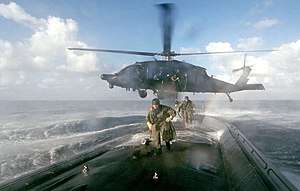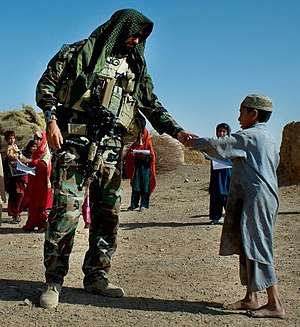7th Special Forces Group (United States)
The 7th Special Forces Group (Airborne) [7th SFG(A)] is an operational unit of the United States Army Special Forces activated on 20 May 1960. It was reorganized from the 77th Special Forces Group, which was also stationed at Fort Bragg, North Carolina. 7th Group—as it is sometime called—is designed to deploy and execute nine doctrinal missions: unconventional warfare, foreign internal defense, direct action, counter-insurgency, special reconnaissance, counter-terrorism, information operations, counterproliferation of weapon of mass destruction, and security force assistance.[8] The 7th SFG(A) spends much of its time conducting foreign internal defense, counter-drug, and training missions of friendly governments' armed forces in South, Central, and North America as well as the Caribbean. 7th SFG(A) participated in Operation Urgent Fury in Grenada in 1983, and in Operation Just Cause in Panama in 1989. The 7th SFG(S) has, like all the SFGs, been heavily deployed to Iraq and Afghanistan in the War on Terror.[9]
| 7th Special Forces Group (Airborne) | |
|---|---|
 7th Special Forces Group beret flash | |
| Active | 1942–45 {disbanded} 1960 – present |
| Country | |
| Branch | |
| Type | Special operations force |
| Role | Primary tasks:
|
| Part of | |
| Garrison/HQ | Eglin AFB |
| Nickname(s) | Green Berets, Quiet Professionals,[1] Soldier-Diplomats, Snake Eaters, Bearded Bastards[2] Red Empire[3] |
| Motto(s) | "De Oppresso Liber",[4] Spanish motto, "Lo Que Sea, Cuando Sea, Donde Sea," which translates as "Anything, Anytime, Anywhere."[5] |
| Engagements | Vietnam War Operation Urgent Fury Operation Just Cause War on Terror
|
| Commanders | |
| Current commander | COL John W. Sannes[6] |
| Insignia | |
| Former 7th SFG(A) recognition bar, worn by non-special operations qualified soldiers—in lieu of a beret flash—from the 1960s to 1984[7] | |
| 1st Special Forces Command (Airborne) shoulder sleeve insignia, worn by all 1st SFC(A) units | .png) |
U.S. Special Forces Groups | |
|---|---|
| Previous | Next |
| 6th Special Forces Group | 8th Special Forces Group |
.jpg)


History
World War II
The 7th SFG(A) traces its lineage to the 1st Company, 1st Regiment, 1st Special Service Force, which was established on 9 July 1942 at Fort William Henry Harrison, Montana. The unit was a combined Canadian-American commando unit, designed to conduct raids against Germany's fledgling nuclear capability in northern Europe. However, it was relocated to the Aleutian Islands to fight the Japanese. Upon the successful completion of the Aleutian campaign, the FSSF was transferred to the Mediterranean theater of operations. The unit earned the nickname "The Devil's Brigade" for fighting with distinction at the Anzio beachhead in Italy. It was the first Allied unit to enter Rome in June 1944. The commander of the 1st Regiment, Colonel Alfred C. Marshall, was killed in action leading that assault. The Force next served as an amphibious spearhead for the Allied landings in southern France in August 1944. The high rate of casualties from these campaigns made it necessary to disband the First Special Service Force at Menton, France on 5 December 1944.
77th Special Forces Group
The 77th Special Forces Group (Airborne) was activated at Fort Bragg, NC on 10 November 1953 under command of Lieutenant Colonel Jack T. Shannon. Its motto was "Any Thing, Any Time, Any Place, Any How." The group built rapidly from an initial strength of only 200 soldiers. The 77th Group wore their famous Green Beret headgear for the first time in a retirement parade for XVIII Airborne Corps commander MG Joseph P. Cleland in June, 1955. In the fall of 1955 it deployed into OPERATION SAGEBRUSH in Louisiana, the largest military exercise in the US since World War II. The 77th carried out unconventional warfare operations, the first time this had been employed in a US military exercise. In 1955-56, 77th Group conducted two cycles of mountain warfare training at Camp Hale, Colorado known as EXERCISE LODESTAR ABLE and LODESTAR BAKER. In April 1956 the 77th Special Forces Group transferred four detachments to the Pacific theater to serve as the cadre for the 1st Special Forces Group (Airborne), which activated at Okinawa in June 1957. In 1959, teams from the 77th Special Forces Group began to deploy to Laos under Project Hotfoot in an effort to forestall Communist encroachment in that kingdom. The group also deployed teams to South Vietnam in 1960 to train Vietnamese ranger and special forces personnel.
Reorganization as 7th Group
In 1960, the 77th was reorganized and redesignated as the 7th Special Forces Group (Airborne), 1st Special Forces. In the 1960s, the need for mobile training teams exceeded the capability of the US military, so the 7th Group provided the cadre for the 3rd Special Forces Group (United States) and the 6th Special Forces Group (United States).
Vietnam
The 7th Group was active early in the Vietnam War, first operating in Laos (Operation White Star), and later in other global Cold War operations in addition to Southeast Asia (Laos, Thailand, and South Vietnam). 7th Group was the first unit in South Vietnam to have a member earn a Medal of Honor, Captain Roger Donlon.[10]
Latin America
At the same time, Special Forces were expanding into Latin America. In May 1962, the advance party from Company D, 7th Special Forces Group departed for Fort Gulick, Panama, in the Canal Zone, to establish the 8th Special Forces Group. 8th Group was deactivated in 1972 and the unit redesignated as the 3rd Battalion, 7th Special Forces Group. The entire 7th Special Forces Group was scheduled for inactivation on 1 October 1980, and was unfunded after that in the completed and approved US Army POM. Army Chief of Staff General Edward C. Meyers reversed the decision after USSOUTHCOM briefings and discussions with LTG Wallace H. Nutting, the CINCSOUTH, and LTC Charles Fry, the 3rd Battalion, 7th Special Forces Group commander, regarding the growing threat to Central America and the need for U.S. Army Special Forces to respond to the threat.
Throughout the 1980s, 7th Special Forces Group played a critical advisory role for the El Salvadoran armed forces, which grew from a force of 12,000 to a total of 55,000 men. The Salvadoran military became a highly trained counter-insurgency force under the tutelage of 7th Group.
The 7th Special Forces Group played an important role in preparing the Honduran military to resist and defeat an invasion from Nicaragua. 7th Group also trained the Honduran military in counter-insurgency tactics, which enabled Honduras to defeat the Honduran communist-backed guerrillas.
7th Special Forces Group also became involved in counter narcotics operations in the Andean Ridge countries of Venezuela, Colombia, Ecuador, Peru, and Bolivia. The goal was not just to stop the flow of drugs into the United States, but to stem the violence that resulted from the drug trade in those countries.
During the 3 October 1989 coup against Noriega by some of his troops, members of 7th Group conducted reconnaissance operations near the road that led from the cuartel of Battalion 2000 to Panama City, giving the US Southern Command advanced early warning of the elite Panamanian unit moving to rescue Noriega, who was being held captive in the Panamanian Comandancia. Meanwhile, one 7th Group Company was being readied to take custody of Noriega. When the coup was over and Noriega was released, that company prepared a raid on the Carcelo Modelo where American Kurt Muse was being held for operating an illegal radio station that was broadcasting anti-Noriega programming. That mission was later turned over to 1st SFOD-D and performed on D-Day during Operation Just Cause.
From 19 December 1989 to 31 January 1990, elements of the 7th Special Forces Group participated in Operation Just Cause to restore democracy to Panama. The 7th Group conducted combat operations on D-Day against multiple strategic targets. Over the next two weeks, 7th Special Forces Group conducted many reconnaissance and direct action missions in support of the operation.
When combat operations ceased, Operational Detachments-A and -B fanned out over the entire country, living in villages with the people. 7th Group soldiers restored public utilities such as water and power while maintaining a watch on the (then) new Panamanian Police Force. Non-commissioned officers served as temporary judges and mayors gaining enormous support from the populace.
Global War on Terrorism
Since early 2002, the 7th SFG has deployed almost nonstop in support of Operation Enduring Freedom in Afghanistan. 7th SFG along with the 3rd Special Forces Group are the two SFGs responsible for conducting operations in Afghanistan. The Group has also deployed in support of Operation Iraqi Freedom numerous times, but not as often as Afghanistan. The 7th SFG has lost more SF soldiers in the Global War on Terrorism than any other SFG.
Relocation
In 2011, 7th SFG(A) relocated from Fort Bragg, North Carolina, to Eglin Air Force Base, Florida, as part of the 2005 Base Realignment and Closure (BRAC) round.[11]
The current Group Commander as of July 2019 is COL John W. Sannes, who had wide experience in the 3rd Special Forces Group (United States).[12]
Subordinate units
- 1st Battalion, 7th Special Forces Group (Airborne) - Commanded by LTC Kendrick Forrester
- 2nd Battalion, 7th Special Forces Group (Airborne) - Commanded by LTC Judd Sanford
- 3rd Battalion, 7th Special Forces Group (Airborne) - Commanded by LTC Patrick Toohey
- 4th Battalion, 7th Special Forces Group (Airborne) - Commanded by LTC Ken Nielsen
See also
- Lauri Törni, aka Major Larry Thorne, a former 7th SFG soldier who was killed on a 1965 covert MACV-SOG mission in Vietnam
- Tim Kennedy (fighter), MMA fighter and former 7th SFG soldier
- Donald Blackburn, early commander of the 7th SFG
- Arthur D. Simons, early officer of the 7th SFG, 1958
References
| Wikimedia Commons has media related to 7th Special Forces Group (United States). |
- Stanton, Doug (24 June 2009). "The Quiet Professionals: The Untold Story of U.S. Special Forces in Afghanistan". Huffington Post.
- "Most Popular E-mail Newsletter". USA Today. 9 November 2011.
- "Red Empire welcomes familiar face to take command". US Army. 19 June 2017.
- Stanton, Doug (24 June 2009). "The Quiet Professionals: The Untold Story of U.S. Special Forces in Afghanistan". Huffington Post.
- "7th Special Forces Group (Airborne) changes command". NWF Daily News. 18 July 2019.
- "7th Special Forces Group (Airborne) changes command". NWF Daily News. 18 July 2019.
- US Army Special Forces 1952–84, Bloomsbury Publishing, by Gordon L. Rottman, dated 20 September 2012, ISBN 9781782004462, last accessed 29 March 2019
- Army Special Operations Forces Fact Book 2018 Archived 19 October 2016 at the Wayback Machine, USASOC official website, dated 2018, last accessed 28 July 2019
- "7th SFG". 7th Special Forces Group webpage. Archived from the original on 28 March 2007. Retrieved 3 March 2007.
- "7th SFG". 7th SFG at Global Security. Archived from the original on 10 March 2007. Retrieved 3 March 2007.
- "Archived copy" (PDF). Archived from the original (PDF) on 2 April 2012. Retrieved 8 September 2011.CS1 maint: archived copy as title (link)
- "7th Special Forces Group (Airborne) changes command". NWF Daily News. 18 July 2019.